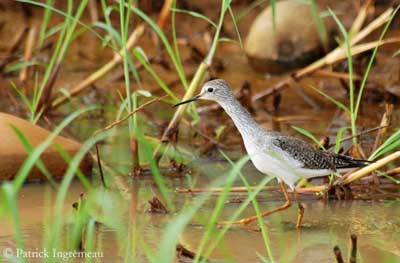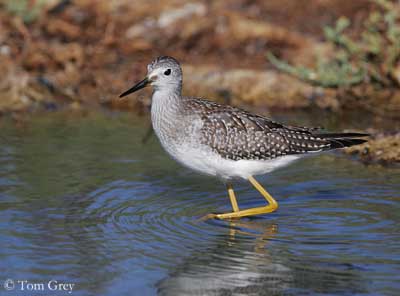
Fr: Chevalier à pattes jaunes
All : Kleiner Gelbschenkel
Esp : Archibebe Patigualdo Chico
Ital: Totano zampegialle minore
Nd: Kleine Geelpootruiter
Sd: Mindre gulbena
Port : Maçarico-de-perna-amarela
Photographers:
Tom Grey
Tom Grey's Bird Pictures
Patrick Ingremeau
TAMANDUA
Bob Moul
Nature Photography
Philippe et Aline Wolfer
OISEAUX D’ARGENTINE
Text by Nicole bouglouan
Sources:
HANDBOOK OF THE BIRDS OF THE WORLD Volume 3 by Josep del Hoyo-Andrew Elliott-Jordi Sargatal - Lynx Edicions - ISBN : 8487334202
A GUIDE TO THE BIRDS OF MEXICO AND NORTHERN CENTRAL AMERICA by Steve N. G. Howell, Sophie Webb - Oxford University Press - ISBN: 0198540124
GUIDE DES LIMICOLES de D. Taylor - Delachaux et Niestlé - ISBN : 2603014080
SHOREBIRDS by Peter Hayman, John Marchant and Tony Prater – Christopher Helm – 1986 – ISBN: 0747014035
All About Birds (Cornell Lab of Ornithology)
Bird Web (Seattle Audubon Society)
South Dakota Birds and Birding (Terry L. Sohl)
Lesser Yellowlegs
Tringa flavipes
Charadriiforme Order – Scolopacidae Family
BIOMETRICS:
Length: 23-25 cm
Wingspan: 59-64 cm
Weight: 85 g
DESCRIPTION:
Very typical of the genus Tringa, the Lesser Yellowlegs is a medium-sized American shorebird, but regular vagrant to Western Europe.
The Lesser Yellowlegs has slender body. Its plumage is greyish finely spotted white, darker on the upperparts with grey-brown wing-coverts. Belly and rump are white. The tail is white with fine dark streaks.
Neck, head and breast are white, densely speckled dark brown.
The bill is thin, straight and black. The eyes are dark brown. Legs and feet are yellow.

The winter plumage is very similar but duller, pale grey with pale spots on inner wings.
Both sexes are similar, but female has slightly longer wings than male.
The juvenile has dark brown back and wings with buff spots. The head is streaked brown, with white eyebrow and eye-ring. Breast and flanks are tinged brownish-grey with few markings. Belly is white. Bill and legs are similar to those of adults.
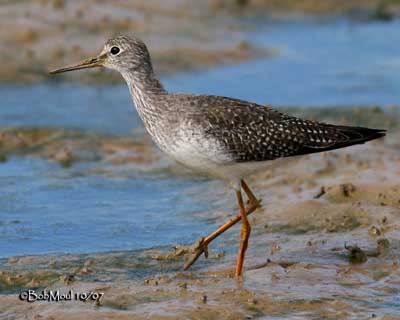
VOICE: SOUNDS BY XENO-CANTO
The Lesser Yellowlegs gives a monotonous, slightly harsh call in flight, « kiouw-kiouw » or a single « kiouw ». It can also utter a tiny, high-pitched, two-note whistle while flying.
The alarm call is a sharp “kip”. When excited, it gives repeated “tiw-tiw”. Sometimes, we can hear more musical sound “pill-i-wiii”.
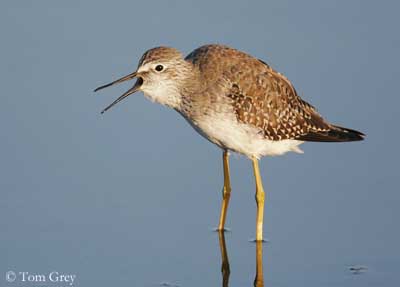
HABITAT:
The Lesser Yellowlegs breeds in tundra and also in clearings in tall open woodland with sparse undergrowth. It frequents the shores of lagoons and rivers, estuaries and marshy areas, to the wet cultivated fields except the mountainous regions.
Outside the breeding season, we can find it in coastal or inland wet areas with emergent vegetation, included flooded agricultural fields and grasslands, and all kinds of places with water, from mangroves, marshes and dams, to salt-marshes and mudflats.
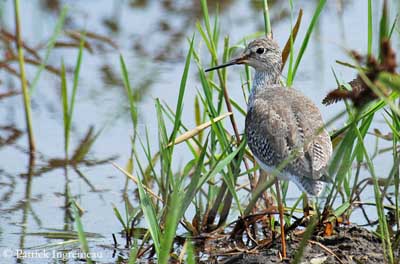
RANGE:
The Lesser Yellowlegs breeds in Canada and Alaska. It migrates during the boreal winter towards the southern hemisphere, to Tierra del Fuego. It winters in South America, in West Indies and sometimes in Falkland’s Islands.
BEHAVIOUR:
The Lesser Yellowlegs is very noisy on its breeding grounds. But during winter, it defends its feeding area by frightening the other birds, included larger than itself and does not appear very gregarious.
But we can find it in large flocks when migrating, and they travel long distances.
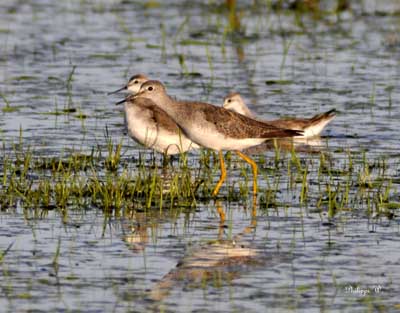
It may sometimes join other shorebirds. They walk on the floating vegetation of lagoons and lakes with typical high-stepping walk, searching for their preferred invertebrates. In order to catch the fishes within shoals, they hunt together by walking up in rows and to concentrate the preys in smaller area to catch them easily. But usually, this shorebird is solitary, not communal fisher.
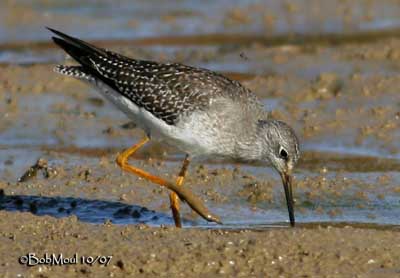
It may swim sometimes, or walk into the water, immerged until the belly. It forages in shallow waters, often running to catch small fishes, tadpoles or aquatic insects. It also pecks from water or mud surface, and moves the long bill sideway. It rarely probes.
It feeds by sight during the day, but by night, it uses its very sensible and flexible bill tip.
The Lesser Yellowlegs is monogamous for the season and the pair forms after the arrival on the breeding areas. The male performs aerial displays with undulating flight, in order to attract a female. Then, it guards the female during the laying period and chases away from her all the potential rivals.
They often nest in loose colonies near water but in dry place. Both parents defend aggressively the young and the nest-site.
When threatened, they bob the head up and down.
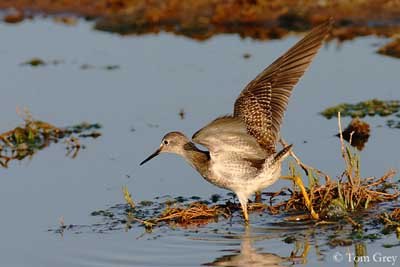
FLIGHT:
The Lesser Yellowlegs performs its flight display with other males, two or small groups, making an undulating flight to attract the females. It has rapid wing-beats.
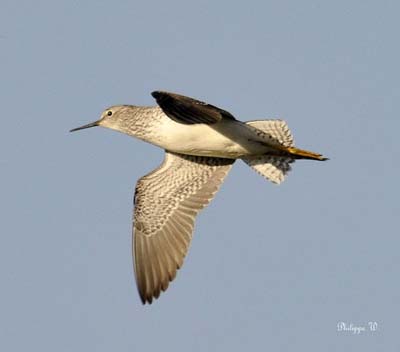
REPRODUCTION:
The breeding season occurs between May and August.
The Lesser Yellowlegs reaches its sexual maturity at about two years. The pair is monogamous for one season and nests in loose colonies.
The nest is a shallow depression, a scrape in the sand, often close to tree trunk, or in hole among the roots of dead tree or on debris. The nest may be sheltered by some vegetation, sometimes among the moss and far from the water. The cup is lined with dead leaves and grasses.
The female lays 3-4 yellowish-buff eggs with dark brown markings. The incubation lasts about 22-23 days, by both parents. The chicks leave the nest very soon after hatching and are able to feed themselves, but they are carefully guarded by the adults. The parents can become very aggressive towards the intruders. Usually, the female leaves the nest-site 11 days after the chicks have hatched and the male rears the young until they fledge, about 23-31 days after hatching.
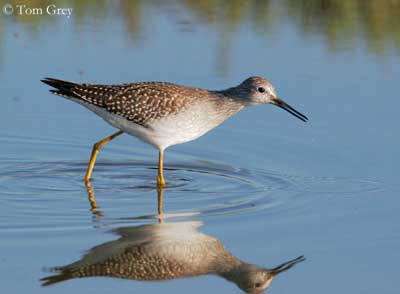
DIET:
The Lesser Yellowlegs feeds on small aquatic animals in the water and on the shores. Sometimes, it also consumes some seeds, crustaceans and small fishes.
During the migrations, it also takes small snails and worms. Its favourite insects are the flies and their larvae, aquatics invertebrates and spiders.
PROTECTION / THREATS / STATUS:
The Lesser Yellowlegs is still sometimes hunted for food. Pesticides, oil pollution and other contaminants are important threats for this species, although its populations are considered correct and stable.
However, numbers seem to decrease, but more information is needed.
